The Furniture: A Nightmare in Sleepy Hollow
 Monday, October 10, 2016 at 9:15AM
Monday, October 10, 2016 at 9:15AM "The Furniture" our weekly series on Production Design. Here's Daniel Walber...
 Sleepy Hollow is an excellent October movie. It has well-placed jack-o-lanterns. Every frame shivers in the autumn chill. Washington Irving’s Hudson Valley falls under perpetually overcast skies, sapping the harvest season of its color. Rather than admire the changing leaves, Tim Burton emphasizes those aspects of fall that foreshadow the bitterness of winter.
Sleepy Hollow is an excellent October movie. It has well-placed jack-o-lanterns. Every frame shivers in the autumn chill. Washington Irving’s Hudson Valley falls under perpetually overcast skies, sapping the harvest season of its color. Rather than admire the changing leaves, Tim Burton emphasizes those aspects of fall that foreshadow the bitterness of winter.
This harsh climate swept up three Oscar nominations, including a win for production design. It’s a testament to Burton’s fanatically specific vision. Location scouting began in Irving’s New York, but the perfect town wasn’t there. It wasn’t in New England, either, nor even in Old England. After all of that searching, the design team ended up building an entire 18th century village from scratch at Leavesden and Shepperton Studios in the UK.

The final product is an expressionistic, spooky riff on colonial life. The credit goes to production designer Rick Heinrichs, whose collaboration with Burton goes as far back as 1982’s Vincent. The set decorations were by Peter Young, who first worked with the director on Batman. Their version of Sleepy Hollow, New York is a clever blend of historical realism and nightmarish fantasy...
Burton’s doesn’t entirely surrender Irving’s original tale to witchcraft and devilry. His Ichabod Crane (Johnny Depp) is a scientific detective, among the first of his kind. He is determined to prove that these Headless Horsemen murders are the work of a mortal. He turns out to be both right and wrong.
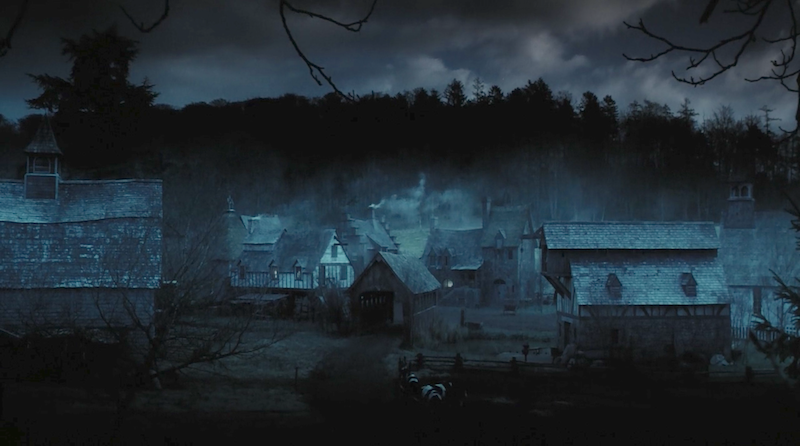
The sets follow suit. Look closely at the town’s structures. Some of them appear realistic, a typical barn and a church with an unremarkable steeple. Others have the curved roofs and bent lines that evoke the stylized architecture we associate with Northern European fairytales.
Heinrichs also uses Irving’s covered bridge, without taking too much artistic license. Yet there’s no apparent reason for it to sit in the middle of town. It’s accurate in construction and uncanny in use.

Of course, it’s not there for its civic usefulness. It’s in the film to frame the following image, a nod to the most iconic representations of the Headless Horseman.
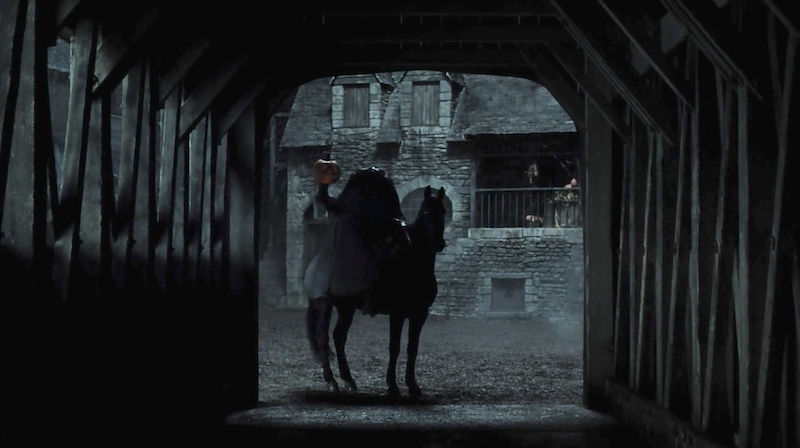
Another example of this balance between the real and the exaggerated can be found in the remains of the old Van Tassel house. The vestiges of the wooden structure seem perfectly normal, but the weird shape of the fireplace hearkens back to the oddly proportioned structures ofThe Nightmare Before Christmas.
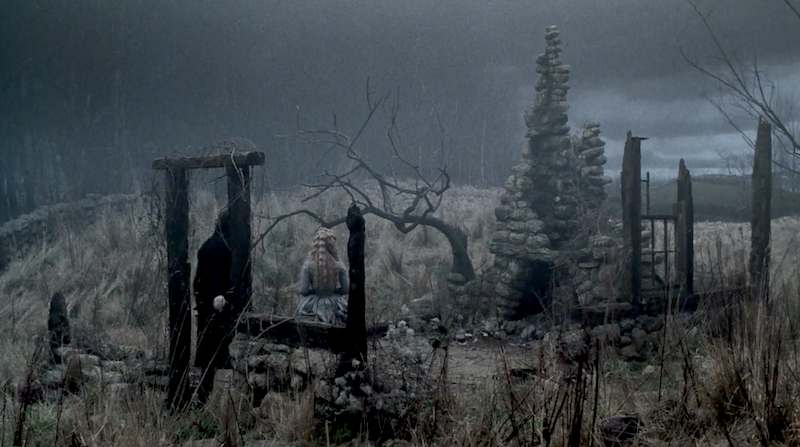
Of course, there are a few especially crazy locations. The Tree of the Dead is warped and beastly, suggesting the living trees of early Disney animation.
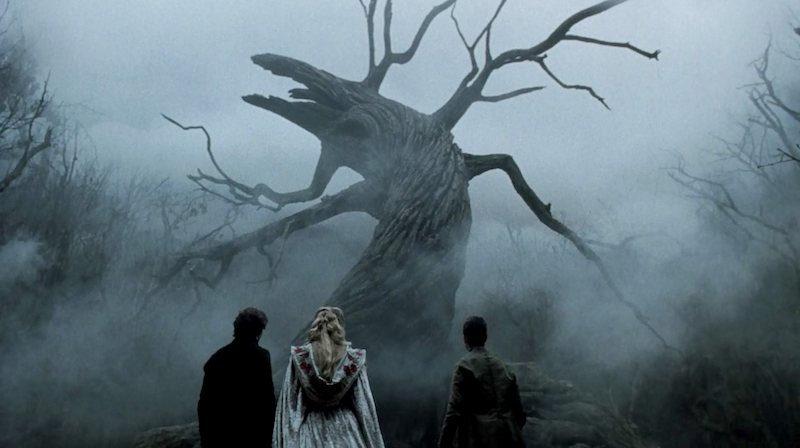
The mill is also a three-dimensional nightmare adaptation of an early Disney cartoon, perhaps a specific reference to the Oscar-winning The Old Mill. And while the tree was created inside a Shepperton sound studio, the exterior shot of the mill was created outside, using forced perspective.
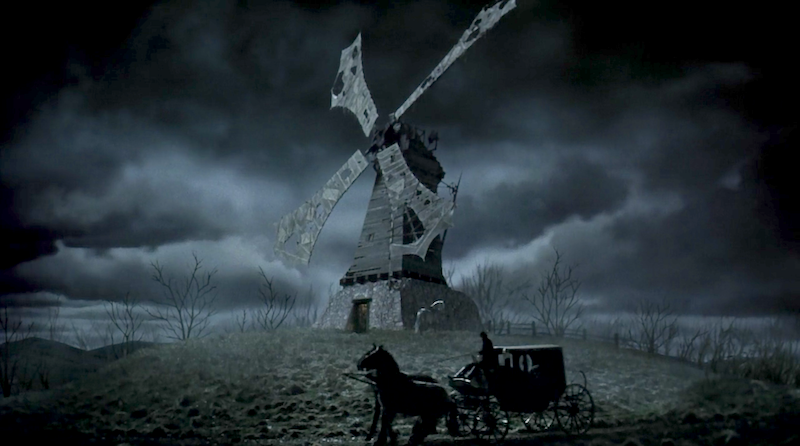
But the mill is the exception. The vast majority of the film was shot indoors. The matte paintings depict the near-constant tempest of the Sleepy Hollow climate. The skies herald the coming of winter, even though the ground has yet to show any signs of snow and ice.
Heinrichs and Burton, at least in this case, understand that a heightened atmosphere can be created without an overwhelming display of showy color, computer generated landscapes and impossible furniture. Here, the otherworldly feeling comes from the fact that Sleepy Hollow is quite literally cut off from the world by painted walls.
They’re most obvious when the narrative is at its most fantastical. Here’s a shot of the Headless Horseman’s brief origin tale, in which the Hessian (Christopher Walken) is finally hunted down by the rebels. It is with this scene that Burton lays the stylistic trajectory of the film, a transparently concocted cinematic unreality that forces the skeptical Crane to let the supernatural into his well-ordered world.
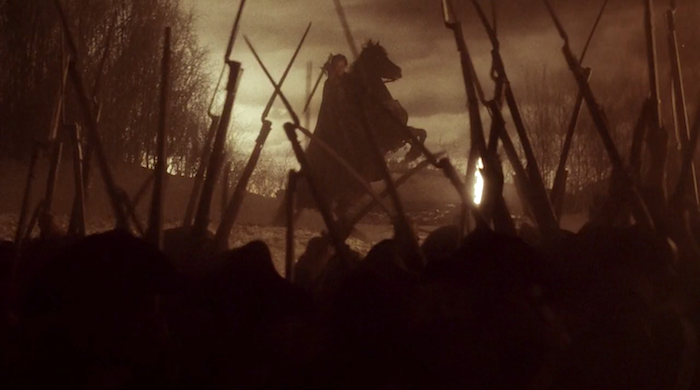
Related 'Scary' articles of "The Furniture"
The Conjuring 2 (2016), The Exorcist (1973), Embrace of the Serpent (2015), The Witch (2015),



Reader Comments (8)
This movie is criminally underrated and probably Burton's masterpiece (for the exceptional supporting cast alone).
I maintain Miranda Richardson and Christopher Walken deserved more praise and some kind of awards attention.
I know that this month it's supposed to have a "scary" theme, but can you later make a The Furniture entry of THE BIRDCAGE? I can't believe that it's nominated only for the glorious production design, but not for the masterpiece performance of Nathan Lane.
The movie gives me chills. Love the set designs and the score.
I'll always love Tim Burton for Beetlejuice, Edward Scissorhands, Batman+Batman Returns, Ed Wood, The Nightmare before Christmas (even though he didn't directed it-but he wrote the story), Sleepy Hollow, Coprse Bride and Frankenweenie. ALWAYS.
And Sweeney Todd. 8)
(too bad Christine Baranski wasn't Mrs. Lovett in the film... *sigh*)
I forgot how beautiful and creepy the production design is in this movie. This post makes me want to rewatch it. And Johnny Depp was still in the early acting phase of his career where he wasn't too mannered or worried about impressing us with an off-kilter character. He serves the movie well.
Great looking movie
While I do find flaws with this film, I cannot deny that it looks and sounds amazing. I am glad it won the Oscar for production design. It also has what I believe is the best horror score since Pyscho.
...Tim Burton's last great (live action) film? I think so. And the production design and overall atmosphere is a HUGE part of that. Another great episode of this series!